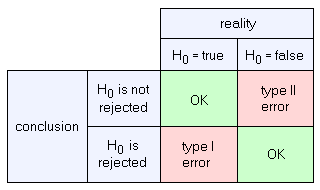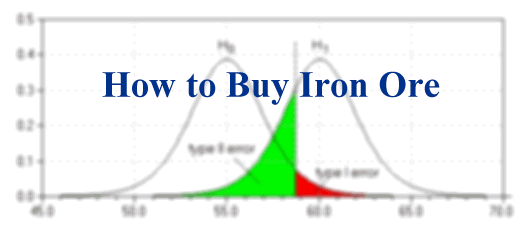| Fundamentals of Statistics contains material of various lectures and courses of H. Lohninger on statistics, data analysis and chemometrics......click here for more. |

|

Home  Statistical Tests Statistical Tests  Fundamendals Fundamendals  Types of Errors Types of Errors |
|||||
| See also: hypothesis testing, power of a test | |||||
Types of ErrorIn general, there are two different types of error that can occur when making a decision: the first kind ("type 1 errors") are those errors which occur when we reject the null hypothesis although the null hypothesis is true. The second kind ("type 2 errors") of errors arise when we accept the null hypothesis although the alternative hypothesis is true. An example should clarify the situation. Suppose you want to buy ore to produce iron. You decide that the ore has to have a certain minimum concentration of iron to be useful for the process. Since the concentration of iron varies for each delivery, you have to ensure that, on average, you receive more than the specified minimum concentration. In order to be cautious you don't trust your suppliers, assuming they can't fulfill your requirements (H0, or null hypothesis). You will believe them only if they can supply evidence that the reqirements are met (H1, or alternative hypothesis). You formulate your hypotheses:
Due to the uncertainties involved in the process of determining the iron content, there is a risk that your decision is wrong. When you decide to buy a particular batch of the ore, and it turns out that the specifications are not met, you have made a type I error (i.e. rejecting H0 when it is true). There is also the possibility that we accept H0, although it is in fact wrong: we don't buy although the specification is met. That is called type 2 error. Since our decision can be false or true, and the null hypothesis can also be false or true, there are four possible outcomes of a test. The probabilities for a type 1 error and type 2 error are usually denoted by α and β, respectively.
In the case given above a type II error does not harm us, except one of the rejected bidders offers a much lower price. But we are concerned about making a type I error, it would mean we would buy the ore without getting the required content of iron. A more elaborate description about type I and type II errors can be found in the following interacte example:
NOTES
|
|||||
Home  Statistical Tests Statistical Tests  Fundamendals Fundamendals  Types of Errors Types of Errors |
|||||



